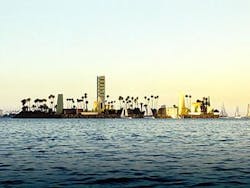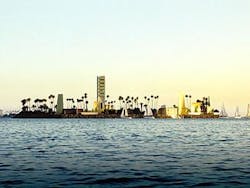THUMS Long Beach Co. Pres. Frank Komin strode quickly from his desk to the window of his Long Beach, Calif., office. His panoramic view of Long Beach Harbor includes the Queen Mary, a boat marina, downtown Long Beach, beaches-and four man-made “oil islands” that his company operates.
Komin’s view reveals an oil operation functioning compatibly and almost invisibly in the ultimate urban fishbowl. THUMS, an agent of Occidental Petroleum Corp. subsidiary Occidental Long Beach, operates the eastern offshore section of California’s 2.4 billion bbl Wilmington oil field, including the huge, mature Long Beach Unit that sits right under Long Beach Harbor.
However, its camouflaged oil production islands look more like tropical oases than industrial sites. Komin says community responsibility is a high priority for the company.
A community pact
For 40 years, THUMS has received good marks from the community for its stewardship of the environment and for operating safely and unobtrusively. In 1962 residents agreed to field development with assurances that oil operations would not be evident.
Four oil production islands were built in Long Beach Harbor and named Grissom, White, Chaffee, and Freeman after the first astronauts who died in the line of duty early in the US space program.
Although more than 1,200 wells have been drilled on these islands, they are not visible to the public, as drilling rigs are enclosed to look like high-rise condos. Concrete sculpture forms, tropical landscaping, and waterfalls also provide camouflage and soundproofing. Quiet electric engines are used. Wells from the islands reach under the harbor to tap oil, which is sent back to the islands for processing, and then piped to shore via subsea lines.
The city of Long Beach is the operator of the Long Beach Unit and shares profits with the government of California, town lot owners, and Oxy, which purchased THUMS in 2000. THUMS serves as contractor to the city and manages daily operations and field development.
THUMS gets its name from the oil property’s original shareholders: Texaco Inc., Humble Oil & Refining Co., Union Oil Co., Mobil Corp., and Shell Oil Co. When oil prices sagged in the late 1990s, field development slowed. To reduce long-term operating costs and boost efficiency and reliability, THUMS launched an infrastructure upgrade program in 2000 to replace field gathering systems and installed field automation and a 46-Mw power plant to reduce losses from volatile power prices. It also injects reclaimed city water to maintain reservoir pressure.
New challenges
Now Komin and the company face new challenges as THUMS steps up efforts to enhance production, slow natural decline, and extend the life of the Long Beach Unit. Robust oil prices have stimulated drilling. As usual, this must be accomplished without adversely impacting the environment, the community, or the safety of employees and contractors.
THUMS has boosted development drilling for bypassed oil to increase production and extend field life. During 2004-06, the company will increase drilling and well work by 50%.
From his office window, Komin pointed to a pair of vessels inching their way from a pier.
“Pump trucks and fracing crews are heading out to the field to do two jobs today,” he said. “These are busy times for us.”
This year, THUMS is drilling 50 development wells, compared with roughly 30 last year.
“We are currently running two drilling rigs and pursuing adding an additional rig. For the first time since 1986, we’ll run three drilling rigs,” Komin said.
For much of the development drilling THUMS will use horizontal and extended reach techniques it pioneered because of the nature of the field.
“The unit has a lot of oil contained in a relatively small surface area, with up to 2,000 ft of vertical oil pay contained in a highly faulted reservoir, which sets up pockets of bypassed oil,” Komin said.
THUMS also is performing more well work this year with its five full-time workover rigs. In addition to using conventional hydraulic fracturing, it is coaxing more oil from wells by importing frac pack technology from the Gulf Coast.
It also is conducting reservoir studies and reprocessing 3D seismic data.
In addition, THUMS is pursuing new opportunities:
• Through an arrangement with the unit, THUMS will use island facilities to drill into the abandoned Belmont oil accumulation, which sits outside the Long Beach Unit.
• A recently completed venture with the city, state, and Oxy will enable THUMS to develop shallow reservoirs of natural gas in the Long Beach Unit later this year.
Because the city of Long Beach is flourishing, the oil islands have new neighbors, including beachfront condominiums and upscale shopping, a new cruise liner berth, and an annual Grand Prix car race.
Maintaining the image
Komin said THUMS is making sure increased oil development doesn’t mean increased community impact.
“We increase activity only if it can be done safely and without impacting the community,” he said. “We consistently scrutinize our operations to ensure the safety of our employees, the integrity of the environment, and the quality of life of our neighbors.”
Noise is a focus because more activity potentially means more noise within earshot of the nearby boat marina, beaches, and condos.
“While our drilling rigs are already enclosed, we can add temporary soundproofing if needed,” explained Komin. “Also, because fracturing can be noisy, we restrict it to daylight hours.”
If a resident complains about noise, Komin says THUMS responds quickly. “For instance, we may add soundproofing, reposition a rig, or move to a daytime operation. We sometimes invite the resident out to the island to see the operations firsthand.”
In a recent $2 million upgrade on islands Grissom and White, THUMS painted rig facades, resurfaced sculpture facades, overhauled waterfalls, and added landscaping.
Odor complaints are rare, Komin says, because the design of the surface facilities prevents emissions. But if there is a complaint, it’s investigated quickly.
A mishap that could cause a leak, spill, or injury is always a concern.
“Achieving superior safety and environmental performance is our goal. A pipeline leak into the ocean would be devastating. It’s never happened, and we can’t let it happen. So we maintain our subsea pipelines to the highest industry standards.”
THUMS regularly sends maintenance pigs through the lines, and periodically injects ultrasonic smart pigs to detect corrosion.
Komin notes that development drilling is being guided by anticollision technology to ensure that new directional wells don’t collide with other wells.
THUMS has more contract drilling and well-service crews on site now. Because many haven’t worked on the islands before, THUMS ensures that they have adequate training to work safely. Contractors must have their own safety people on site to complement the THUMS safety team.
“We impress upon contract personnel that this is a unique oil field environment which needs to be treated differently,” Komin emphasized.
Good community partner
As it ramps up development, THUMS continues to stress community and government relations.
“Coming here was an eye-opener,” said Komin, who previously worked in rural oil fields from West Texas to Alaska. He has learned how to work with government partners and the community.
THUMS and the city annually welcome some 2,000 visitors to its oil islands. Komin and other THUMS managers regularly talk to community groups, and Komin recently appeared on local cable television.
THUMS donates to community causes, and many company employees volunteer their time. Komin is active in several community groups.
The company recently commissioned a study that found that the oil islands provide a habitat for various marine life that has allowed the ecosystem to flourish. A poster showing study results is now on display at the local Aquarium of the Pacific.
THUMS continues to be neighborly. Long Beach marina boat owners having parties have been known to request that the waterfall and nightlights on Island Grissom be left on past 10 p.m. THUMS accommodates them. More than once, a waterfall has been turned on to serve as a backdrop for a wedding on a nearby boat.
THUMS maintains good relations with the mayor and city council, Long Beach Department of Oil Properties (DOP), Port of Long Beach, State Lands Commission, and the state legislature.
DOP, as operator, provides technical oversight and ensures that operations are conducted properly. A DOP operations coordinator roams the oil islands daily, observing.
“We have an open, cooperative partnership with the DOP. Their geologists and engineers work closely with our people, who present ideas for wells and projects. State representatives are also involved,” said Komin.
Communication
THUMS Long Beach may operate in an unusually sensitive urban arena. But as cities sprawl, more operators must coexist with communities. Komin’s advice:
• Be proactive about telling your story.
“Let people know what’s going on. When there is no communication, people usually assume the worst,” he advises.
• Find creative ways to educate the community.
• Be a good neighbor by addressing complaints quickly.
“We’re on our way to producing our billionth barrel, and we hope to be here another 30-40 [years]. Our oil islands are local icons. But if we aren’t good neighbors and stewards of the environment, local support can quickly diminish,” he warns.
• Be accessible to government officials.
“Don’t wait for an emergency to contact government officials. Let them know in advance about something they might have to decide upon,” he added.
• Give back to the community. Komin thinks a proactive attitude is serving THUMS well as it expands field activity.
“We’re making sure our operations don’t create problems for our neighbors and the environment,” he said. “At the same time we’re working with the community to ensure we have a positive overall impact.” ✦
Career highlights
Frank Komin is president and general manager of THUMS Long Beach Co., a unit of Occidental Petroleum Corp.
Employment
Starting with ARCO in 1978, Komin held engineering, operations, and management jobs in the Midcontinent, offshore Gulf Coast, Permian basin, Alaska North Slope, and Los Angeles basin areas. Komin joined Occidental in 2000 as manager of production and development for THUMS, assuming his current job in 2001.
Education
Komin has a degree in petroleum engineering from the University of Kansas.
Associations
Komin is active in the California Independent Petroleum Association, Society of Petroleum Engineers International, American Petroleum Institute, Rotary International, American Red Cross, Salvation Army, and the Long Beach Chamber of Commerce.



